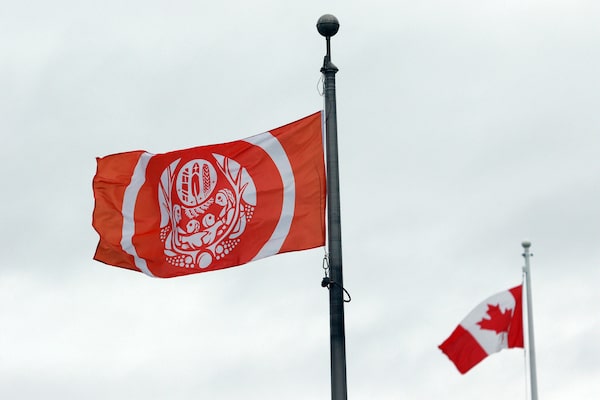
The Survivors’ Flag hangs to honour Indigenous Peoples who were forced to attend residential schools, is shown on the grounds of the legislature in Victoria on Sept. 28, 2022.CHAD HIPOLITO/The Canadian Press
The shishalh Nation on British Columbia’s Sunshine Coast says ground-penetrating radar has identified what are believed to be 40 unmarked graves of children on or near the site of the former St. Augustine’s Residential School.
A statement from the First Nation on Thursday said it listened to elders and survivors of the residential school, and stories shared of missing children have been confirmed.
The shishalh is the latest of several First Nations to announce results of their research into children who went missing while attending residential schools.
In May, 2021, the Tk’emlups te Secwepemc First Nation in Kamloops, B.C., announced the discovery of more than 200 potential unmarked graves using ground-penetrating radar.
Chief Lenora Joe said in the statement that many children who went missing while being forced to attend residential schools may never be found.
“Each time results are shared the number of children’s remains found grows,” Ms. Joe said.
The shishalh Nation said ground-penetrating radar is one of the tools it used in the archeological project, which also included interviews with survivors and records of documented historical events.
The nation said it has been working with the University of Saskatchewan to find the remains of children who didn’t return from St. Augustine’s.
Terry Clark, an associate professor at the university, said they always had enough proof of the remains, and they strongly believe there are many more unmarked graves in the area.
Ms. Joe said they have known the truth and conducted the search to show the children they haven’t been forgotten.
“The children have spoken, and we are listening. We have heard their voices,” the statement said.
The nation said the land where St. Augustine’s operated is in the middle of the municipality of Sechelt, so it has been disturbed and developed.
Depending solely on ground-penetrating radar for data would be inaccurate and inconclusive, it said.
“We know there are more lost children, the researchers are telling us there are more. This is heartbreaking,” Ms. Joe said.
“Some of the children may never be found. We will keep looking.”
Ms. Joe said the children of 51 other nations attended the school, which operated between 1904 and 1975.
In a video statement accompanying the announcement, Ms. Joe said the community is fragile as members and survivors process the grim news.
“These children were our aunties, they were our uncles, they were our future leaders that we never met,” she said. “They never grew up and decades later, they are still lost children.”
Ms. Joe said she understands people may have many questions about the discovery, but urged people to give them time to allow the nation to heal and support their efforts in other ways.
“If you would like to offer support, please wear an orange shirt, fly your flags at half-mast and cherish moments with your children and your families,” she said.
The Truth and Reconciliation Commission has said parents withdrew their children in 1923 from St. Augustine’s to protest poor education, harsh discipline and inadequate diet. It said officials responded by appointing a new principal and increasing school funding.
Residential school survivors and their relatives suffering trauma invoked by the recall of past abuse can access the National Residential School Crisis Line at 1-866-925-4419.